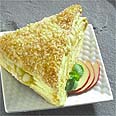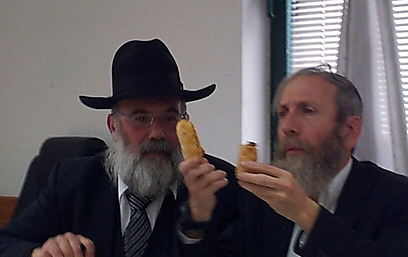
Dairy or parve?
After the marriage registration reform
, here comes the "bourekas revolution": The Chief Rabbinate of Israel
has issued new kosher procedures, obliging manufacturers of one of the country's most popular pastries to design them in uniform and fixed shapes to prevent confusion between dairy and parve (neither meat nor milk) products.
The move's initiators were concerned that kashrut observers, who wait several hours between eating meat and dairy products, will "fail" by eating pastries containing cheese just because they were mistakenly assumed to be parve due to their shape.
From now on, each pastry will have to be made in the shape determined by the type of dough and ingredients of its stuffing, as a basic condition for receiving a kashrut certificate.
Warning
Itzchak Tessler
Chief Rabbinate warns Israeli public against Coca-Cola manufactured without supervision in PA. Businesses asked to avoid selling beverage 'so as not to get public used to purchasing products without kosher mark'
Under the new procedures, a parve pastry made of filo dough will be shaped as a closed triangle or spiral, while a dairy pastry will be circular or shaped like a "large finger." Parve croissants or rugelach, on the other hand, will be baked as straight rectangle, while the dairy ones will be crescent-shaped.
The new rules are an expansion of the existing, relatively limited procedure, which states that dairy bourekas should be baked as a triangle and parve bourekas must be square-shaped.

Chief Rabbinate officials closely examine bourekas (Photo: Dvora Ginzburg)
Officials at the Rabbinate's Kashrut Department explained that bourekas was a special product kosher-wise, as it is marketed without a separate packaging for each item and is often served at events without any kosher mark so that kashrut observers have no way of knowing whether it is parve or dairy. Thus, the pastry's shape is the only reasonable means for recognizing the product's classification.
"In recent years, there has been a lot of creativity in the area of pastries and the variety of flavors and fillings has increased – as has the variety of shapes, leading to multiple failures," a Rabbinate official said.
"Several months ago, we began working on the procedures in a dialogue with owners of the large bakeries about the different production possibilities. The procedure eventually accepted fits the technological conditions existing in the industry today and is accepted by most major manufacturers."
The Rabbinate's Kashrut Department first convened to plan "Operation Bourekas" about half a year ago. Rabbi Hagai Bar Giora of the Kashrut Department said at the time that he had recently received a complaint from people vacationing in a hotel in northern Israel, who ate a cheese bourekas shortly after eating meat as they mistakenly assumed that it was parve due to its shape.
Rabbi Bar Giora noted that this was not just a halachic-religious matter but posed a health risk as well, as people allergic to dairy products might accidentally eat a cheese bourekas.















